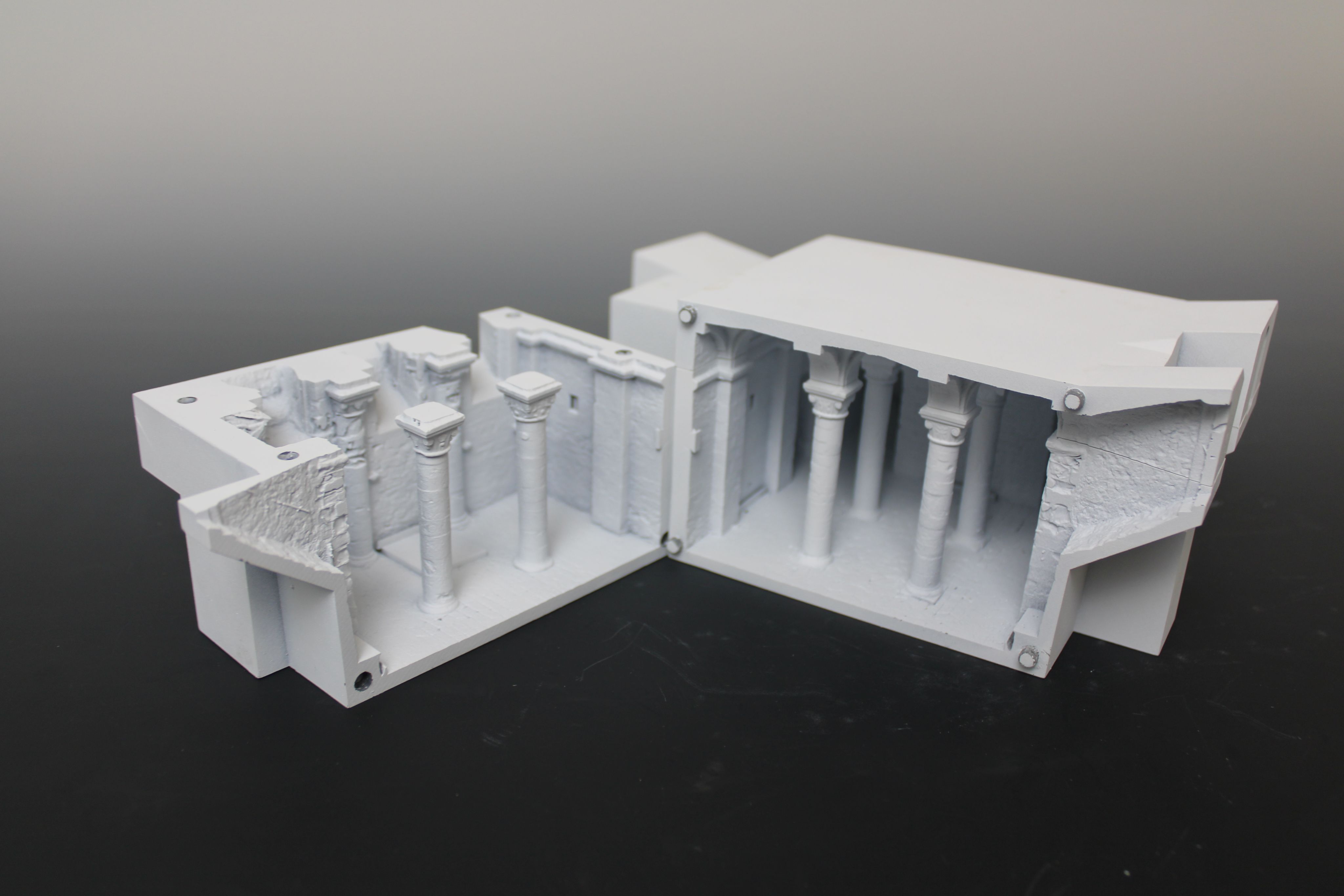Object Gallery

The Apprentice’s Capital
Many imaginative carvings can be seen in Durham Castle, especially in the Norman Chapel. Animal images with spiritual attributes decorate the walls and capitals. The Norman Chapel features images of creatures such as: a mermaid; a lion; an ox; a snake. Similar carvings can be seen on this unfinished capital, probably designed by an apprentice stonemason.
Time and Tradition
Laurence of Durham
One of the earliest references to the Norman Chapel is a 12th Century Poem by Laurence of Durham. It reads, “And here stands a glorious chapel, supported by six columns. Not too spacious, but beautiful enough.” His simple summary still works today even though the Chapel has gone through many changes since he last saw it.
Prayer Book
This book was most likely used in the Tunstall Chapel, just above the sleeping Norman Chapel that was closed from the 12th century till 1840. This leather-bound book titled “Durham Chapel,” was used to deliver prayers and give religious instructions within the Castle. The book was printed by the king’s printer, John Baskett, in 1739.
University College Badges
These badges from the early 2000s were worn by ‘Castle’ students to show their college pride. Many of these badges feature references to the annual June Ball. The first June Ball occurred in 1889 as a celebratory event following the exam period. Featured in The Guardian’s ‘Top 100 Things To Do Before You Die’, the June Ball has been cemented as an iconic part of Durham’s history.
Royal Air Force Book
From 1941 to 1946 the Norman Chapel served as a Royal Airforce observation and command post. After the war, the space circled back to being a working chapel, but also became a memorial dedicated to those who lost their lives in the Second World War. This book keeps the records of those who trained at Durham Castle before going to war.
UNESCO certification
The World Heritage Committee officially listed Durham Castle and Cathedral on the The World Heritage List in 1986. Inscription on this list confirms the exceptional and universal value of a cultural or natural site which requires protection for the benefit of all humanity.
Conservation and the Castle: how to care for a piece of living history
Model of the Norman Chapel
This 3D printed model was produced using photos of the Chapel. The model comes apart to showcase individual architectural features and give an overhead view of the building.
Slate Brick
This slab of slate was probably used for roofing. This was found by archaeologists at the Norman Chapel dig site with a broken nail hanging on one edge. It is like those used in Victorian and early 20th century construction.
Sandstone
A block of sandstone from the ongoing construction of the Norman Chapel. Sandstone is easily eroded by moisture which creates the curving hollows seen on damaged stones in the Norman Chapel.
Durham Castle Preservation Fund Medal
Most likely a token to funders of the 1927-1937 Durham Castle repair programme. Durham Castle was at risk of collapse in the late 1920s due to the Castle being built on unstable ground. It is estimated that £150,000 was required for the project. Funds were raised by the Lord Bishop of Durham through a nation-wide plea in 1928 to save the Castle.
Construction and Archaeology: never one without the other
Silver Coin
This worn silver halfpenny was found during the archaeological work at the Norman Chapel. The original penny would have been deliberately cut in half to decrease its value to make a smaller purchase.
The irregularly shaped edges on the coin suggest that it may have been illegally clipped to harvest spare silver.
Bone Dice
This bone dice has an unusual arrangement for a medieval dice. Typically, medieval dice are numbered so that the opposite sides add up to seven. This dice is more typical of Roman style dice, where opposite sides of the dice do not add up to seven. It was found alongside medieval finds, suggesting that this Roman dice was used up until the medieval era.
It could have been used to play medieval games such as Hazard where a person threw a die after saying the number they wanted to roll. If the person rolled that number, everyone playing had to pay them, but if they failed, they had to pay everyone else.
Stone Gaming Counter
This sandstone disc was possibly used as a gaming piece or counter. Medieval gaming counters are commonly found during archaeological excavations, though they are less common than dice. This is probably because they are very difficult to spot in amongst other sandstone pebbles and stones.
Pieces like this one were often used in a board game called Nine Men’s Morris where players started with nine counters and aimed to take their opponent’s counters off the board.
Craftsmen and Labour: a historic tapestry
Oyster Shells
This collection of oyster shells was found within the Chapel’s walls during archaeological work. These shells were part of the diet for those who lived and worked at Durham Castle. Oysters were cheap and readily available, making them a common food for the working class. Once the oysters were eaten, the shells were often repurposed as building materials to level out the gaps in external walls.
Image courtesy of Durham County Record Office
Image courtesy of Durham County Record Office
Tweed Flat Cap
During the Victorian period builders often wore thick tweed clothing. Tweed not only provided warmth, but the densely woven fabric was also used for its water-resistant qualities and protection in inclement British weather.
Hi-Vis Jacket & Construction Helmet
Today’s construction workers use high visibility clothing to prevent accidents. Reflective materials ensure that builders can be seen in poor light conditions. It has become the uniform of the modern construction worker and a compulsory on site precaution
Today helmets are made from tough materials such as polymers, plastics, glass fibres or metal. This protects the head from impact if an accident occurs. Helmets are a modern requirement for a building site.
Food, Banquets, and Pets: living it up in Durham Castle
Dinner Setting
This plate, dinner cover, and cutlery represent a longstanding tradition of banqueting at Durham Castle. Continuing this rich history, University College now holds formal dinners to build lasting friendships amongst students.
Drink Bottles
Bell and Riddle was a chemist established in 1831 in Hexham. This regional company fed the nineteenth century’s love for sparkling water by producing bottles of aerated water. This bottle is one of several that were found while repairing the Castle’s undercroft steps.
Fish Bones
Many archaeological surveys at Durham Castle have found large amounts of fish bones. This suggests that fish was a dietary staple from at least the Medieval Period. The fish were likely caught at sea or in the river and transported to the Castle.
Raven Bone
This is a raven's scapula or shoulder blade. It shows signs of a previous breakage that was healed. The fractured bone would have affected the raven's ability to fly, meaning that it may have received care for some time to allow the bone to mend. This species could be a companion animal, comparable to cats and dogs.
Paw Print Ceramic
This piece of pottery appears normal at first glance, but it also hides a special story. Every pet owner has seen this design stamped across the floor at one point or another: a paw print! Whether the paw was pressed into the wet clay, or someone carefully copied the shape, this is evidence of humanity’s age-old love for our four-legged friends.
Jawbone
These teeth belonged to an adult cow who lived before 1660. The condition of the teeth show that they have chewed through a lot of plants. Cattle were raised for various dairy products and meat cuts that may have made up the diet of the 17th century inhabitants of the Castle. The process of caring for, milking, and butchering cows made up many people’s livelihood.
Your feedback is important to us. Please take a moment to complete this short feedback form.






















